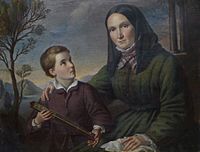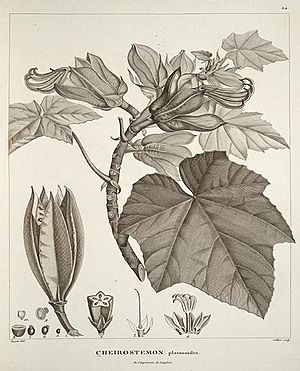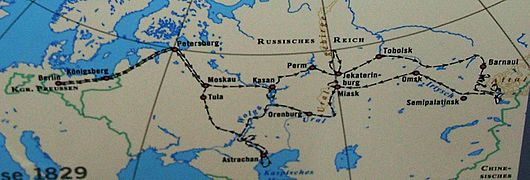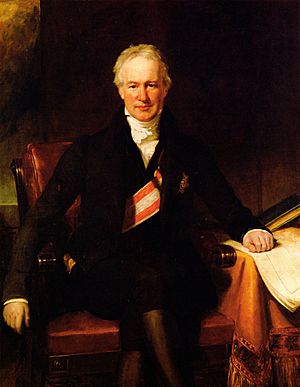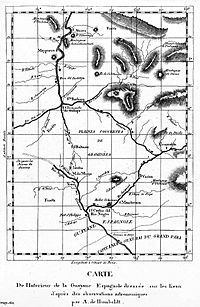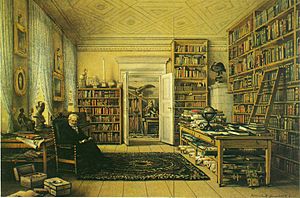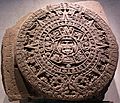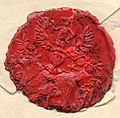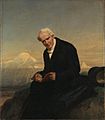Alexander von Humboldt facts for kids
Quick facts for kids
Alexander von Humboldt
|
|
|---|---|
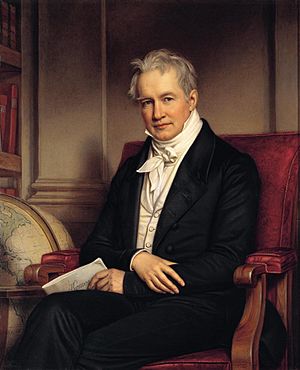
Portrait by Joseph Karl Stieler (1843)
|
|
| Born | 14 September 1769 |
| Died | 6 May 1859 (aged 89) |
| Resting place | Schloss Tegel |
| Nationality | German |
| Alma mater | Freiberg School of Mines (diploma, 1792) University of Frankfurt (Oder) (no degree) University of Göttingen (no degree) University of Berlin (no degree) |
| Known for | Biogeography, Kosmos (1845–1862), Humboldt Current, magnetic storm, Humboldtian science, Berlin Romanticism |
| Awards | Copley Medal (1852) |
| Scientific career | |
| Fields | Geography |
| Academic advisors | Markus Herz, Carl Ludwig Willdenow, Abraham Gottlob Werner |
| Notable students | Louis Agassiz |
| Influences | F. W. J. Schelling |
| Influenced | Darwin, Wallace, Thoreau, Whitman, Emerson, Muir, Irving, Ida Laura Pfeiffer, Frederic Edwin Church, Ernst Haeckel, George Perkins Marsh |
| Signature | |
Alexander von Humboldt (Berlin, 14 September 1769 – Berlin, 6 May 1859) was a Prussian naturalist and explorer. Humboldt's work on botanical geography was very important in the field of biogeography. He is seen as "the father of ecology" and "the father of environmentalism".
Contents
Early life
Humboldt was born in Berlin. His father, Alexander Georg von Humboldt, was a major in the Prussian Army. He married Maria Elizabeth von Colomb, a well-educated woman, in 1766. The couple had two sons, the younger was Alexander. Alexander's elder brother was the Prussian minister, philosopher, and linguist Wilhelm von Humboldt.
In his childhood Humboldt already liked to collect plants, shells, and insects. This interest earned him a nickname - "the little apothecary".
Humboldt's father died very early (in 1779). From that time on his mother took care of his education.
Education
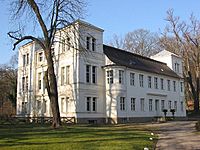
Alexander studied finance for six months in 1787 at the University of Frankfurt (Oder). On 25 April 1789, he matriculated at the University of Göttingen. Humboldt's passion for travel was of long standing. He devoted to prepare himself as a scientific explorer. With this emphasis, he studied commerce and foreign languages at Hamburg, geology at Freiberg School of Mines, anatomy at Jena as well as astronomy and the use of scientific instruments.
Travels
Between 1799 and 1804, Humboldt travelled extensively in the Americas, exploring and describing them for the first time from a scientific point of view. His description of the journey was written up and published in several volumes over 21 years. Humboldt was one of the first people to propose that the lands bordering the Atlantic Ocean were once joined (South America and Africa in particular).
Achievements of the Latin American expedition
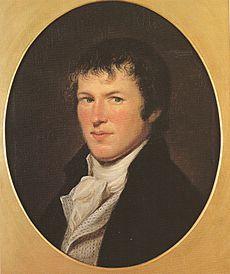
Humboldt's expedition laid the foundation of the sciences of physical geography, plant geography, and meteorology. He closely observed plant and animal species in situ, not just in isolation, noting all elements in relation to one other. He collected specimens of plants and animals, dividing the growing collection so that if a portion was lost, other parts might survive.
Humboldt believed that everything should be measured with the finest and most modern instruments available. This quantitative methodology would become known as Humboldtian science.
Humboldt also studied the volcanoes of the Andes and Mexico, which he observed and sketched, climbed, and measured with a variety of instruments. By climbing Chimborazo, he established an altitude record which became the basis for measurement of other volcanoes in the Andes and the Himalayas.
Humboldt was a significant contributor to cartography, creating maps, particularly of New Spain, that became the template for later mapmakers in Mexico. He conducted a census of the indigenous and European inhabitants in New Spain. He estimated the population to be six million individuals. He estimated Indians to be forty percent of New Spain's population, but their distribution being uneven; the most dense were in the center and south of Mexico, the least dense in the north.
Humboldt was not primarily an artist, but he could draw well, allowing him to record a visual record of particular places and their natural environment. Many of his drawings became the basis for illustrations of his many scientific and general publications.
Expedition in Russia, 1829
Humboldt's 1829 expedition to Russia is much less known than his five-year travels in Spanish America. Czar Nicholas I of Russia invited Humboldt to visit the Ural Mountains. The Russian government was interested in Humboldt's finding prospects for mining and commercial advancement of the realm and sought to entice Humboldt by engaging his enduring interest in mining sites, for comparative scientific purposes for Humboldt.
In 1829, Humboldt traversed the wide expanse of the Russian empire from the Neva to the Yenisei, accomplishing in twenty-five weeks a distance of 9,614 miles (15,472 km). The itinerary was planned with Tobolsk the farthest destination, then a return to Saint Petersburg. The expedition took 8 months, travelled 15,500 km, stopped at 658 post stations, and used 12,244 horses. However, the journey was too rapid to be profitable scientifically. Humboldt published two works on the Russian expedition. In 1843, he completed the three-volume Asie Centrale, which he dedicated to Czar Nicholas. As of 2016, these works have not been translated to English.
Scholarly and public recognition
During his lifetime Humboldt became one of the most famous men in Europe. Academies, both native and foreign, were eager to elect him to their membership.
After Mexican independence from Spain in 1821, the Mexican government recognized him with high honors for his services to the nation. In 1827, the first President of Mexico, Guadalupe Victoria granted Humboldt Mexican citizenship and in 1859, the President of Mexico, Benito Juárez, named Humboldt a hero of the nation (benemérito de la nación). The gestures were purely honorary; he never returned to the Americas following his expedition.
Importantly for Humboldt's long-term financial stability, King Frederick William III of Prussia conferred upon him the honor of the post of royal chamberlain. The appointment had a pension of 2,500 thalers, afterwards doubled. This official stipend became his main source of income in later years when he exhausted his fortune on the publications of his research.
On 12 May 1827 he settled permanently in Berlin, where his first efforts were directed towards the furtherance of the science of terrestrial magnetism. In 1827, he began giving public lectures in Berlin, which became the basis for his last major publication, Kosmos (1845–62).
In 1869, the 100th year of his birth, Humboldt's fame was so great that cities all over America celebrated his birth with large festivals. In New York City, a bust of his head was unveiled in Central Park.
Travel diaries
Humboldt kept a detailed diary of his sojourn to Spanish America, running some 4,000 pages, which he drew on directly for his multiple publications following the expedition. The leather-bound diaries themselves are now in Germany, having been returned from Russia to East Germany, where they were taken by the Red Army after World War II. Following German reunification, the diaries were returned to a descendant of Humboldt. For a time, there was concern about their being sold, but that was averted. A government-funded project to digitize the Spanish American expedition as well as his later Russian expedition has been undertaken (2014–2017) by the University of Potsdam and the German State Library–Prussian Cultural Heritage Foundation.
Other publications
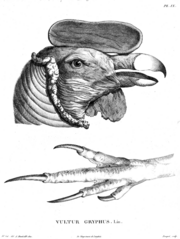
Alexander von Humboldt published prolifically throughout his life. Many works were published originally in French or German, then translated to other languages, sometimes with competing translation editions. Humboldt himself did not keep track of all the various editions. He wrote specialized works on particular topics of botany, zoology, astronomy, mineralogy, among others, but he also wrote general works that attracted a wide readership, especially his Personal Narrative of Travels to the Equinoctial Regions of the New Continent during the years 1799–1804 His Political Essay on the Kingdom of New Spain was widely read in Mexico itself, the United States, as well as in Europe.
Many of the original works have been digitally scanned by the Biodiversity Library. There have been new editions of print works, including his Views of the Cordilleras and Monuments of the Indigenous Peoples of the Americas (2014), which includes reproductions of all the color and black and white plates. In the original edition, the publication was in a large format and quite expensive. There is a 2009 translation of his Geography of Plants and a 2014 English edition of Views of Nature.
Personal life
Much of Humboldt's private life remains a mystery because he destroyed his private letters.
Humboldt never married.
Humboldt inherited a significant fortune, but the expense of his travels, and most especially of publishing (thirty volumes in all), had by 1834 made him totally reliant on the pension of King Frederick William III. Although he preferred living in Paris, by 1836 the King had insisted he return to Germany. He lived with the Court at Sanssouci, and latterly in Berlin, with his valet Seifert, who had accompanied him to Russia in 1829.
Four years before his death, Humboldt executed a deed of gift transferring his entire estate to Seifert, who had by then married and set up a household near Humboldt's apartment. Humboldt had become godfather to his daughter.
Illness and death

On 24 February 1857, Humboldt suffered a minor stroke, which passed without perceptible symptoms. It was not until the winter of 1858–1859 that his strength began to decline; on 6 May 1859, he died peacefully in Berlin, aged 89. His last words were reported to be "How glorious these sunbeams are! They seem to call Earth to the Heavens!" His remains were conveyed in state through the streets of Berlin, in a hearse drawn by six horses. Royal chamberlains led the cortège, each charged with carrying a pillow with Humboldt's medals and other decorations of honor. Humboldt's extended family, descendants of his brother Wilhelm, walked in the procession. Humboldt's coffin was received by the prince-regent at the door of the cathedral. He was interred at the family resting-place at Tegel, alongside his brother Wilhelm and sister-in-law Caroline.
Honours and namesakes
The honours which had been showered on Humboldt during life continued after his death. More species are named after Humboldt than after any other human being. The first centenary of Humboldt's birth was celebrated on 14 September 1869, with great enthusiasm in both the New and Old Worlds. Numerous monuments were constructed in his honour, such as Humboldt Park in Chicago, planned that year and constructed shortly after the Chicago fire. Newly explored regions and species named after Humboldt also stand as a measure of his wide fame and popularity.
Honours
- 1829: Actual Privy Counsellor, with the title of Excellency by King Frederick William III of Prussia
- 1842: Chancellor of the Order of Merit, an administrative position empowered to appoint, by King Frederick William IV of Prussia
- 1842: Pour le Mérite, Recipient (civil division)
- 1844: Order of the Red Eagle, by King Frederick William IV of Prussia
- 1847: Order of the Black Eagle, by King Frederick William IV of Prussia, the highest honour that was in the royal power to confer.
- 1850: Knight Grand Cross of the Order of Saints Maurice and Lazarus
- 1852: Copley Medal "For his eminent services in terrestrial physics"
- 1853: Bavarian Maximilian Order for Science and Art by King Maximilian II of Bavaria "as the man who honours the order", "the hero of science in Germany".
- 1863: Knight Grand Cross of the Order of Guadalupe
Images for kids
-
Schiller, Wilhelm, and Alexander von Humboldt with Goethe in Jena
-
Charles IV of Spain who authorized Humboldt's travels and research in Spanish America
-
Humboldt and Aimé Bonpland were in the Amazon rainforest by the Casiquiare River, with their scientific instruments, which enabled them to take many types of accurate measurements throughout their five-year journey. Oil painting by Eduard Ender, 1856.
-
Humboldt and his fellow scientist Aimé Bonpland near the foot of the Chimborazo volcano, painting by Friedrich Georg Weitsch (1810)
-
Basalt prisms at Santa María Regla, Mexico by Alexander von Humboldt, published in Vue des Cordillères et monuments des peuples indigènes de l'Amérique
-
Humboldt's Naturgemälde, also known as the Chimborazo Map, is his depiction of the volcanoes Chimborazo and Cotopaxi in cross section, with detailed information about plant geography. The illustration was published in The Geography of Plants, 1807, in a large format (54 cm x 84 cm). Largely used for global warming analyses, this map depicts in fact the vegetation of another volcano: the Antisana.
-
Humboldt's seal on a private letter
-
Portrait of Humboldt by Julius Schrader, 1859. Metropolitan Museum of Art
-
House where Humboldt and Bonpland lived in Mexico City in 1803, located at 80 Rep. de Uruguay in the historic centre, just south of the Zocalo
-
Statue of Humboldt in Cuernavaca, Mexico
-
Waterfall over the Basaltic Prisms of Santa María Regla, Huasca de Ocampo, Hidalgo, Mexico, that Humboldt sketched
-
Ferdinand Bellermann, Colonia Tovar
-
Humboldt penguin, native to Chile and Peru
-
Humboldt squid found in the Humboldt Current
-
Pico Humboldt, Venezuela
-
Statue in Allegheny West Park, Pittsburgh, Pennsylvania
-
Statue in Alameda Central, Mexico City
-
Humboldt, part of a sculpture in Cologne, Germany
-
Statue in Tower Grove Park, St. Louis
See also
 In Spanish: Alexander von Humboldt para niños
In Spanish: Alexander von Humboldt para niños


